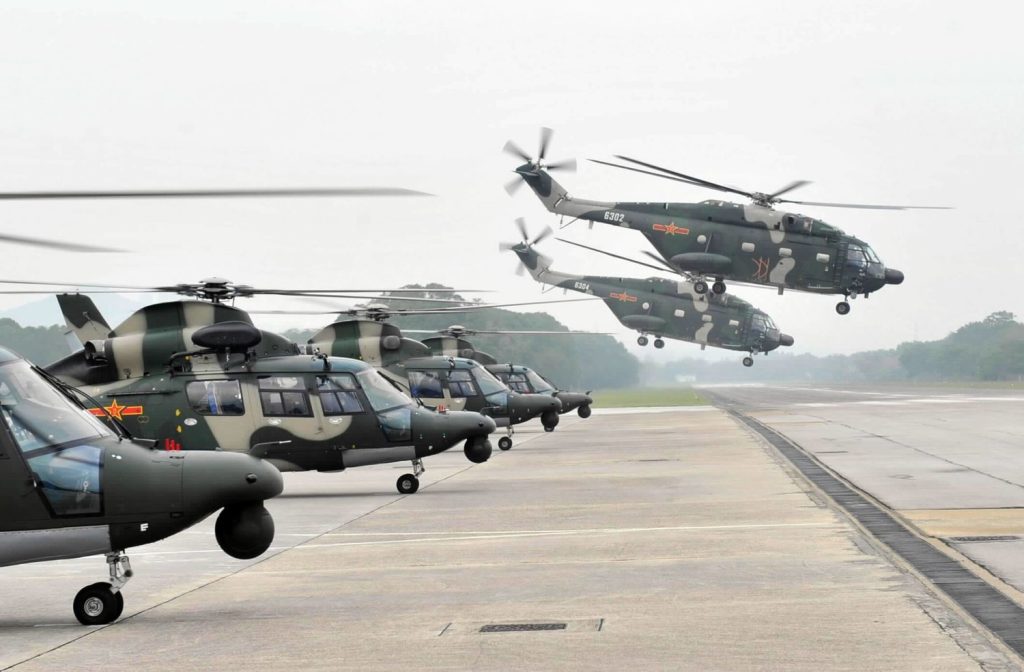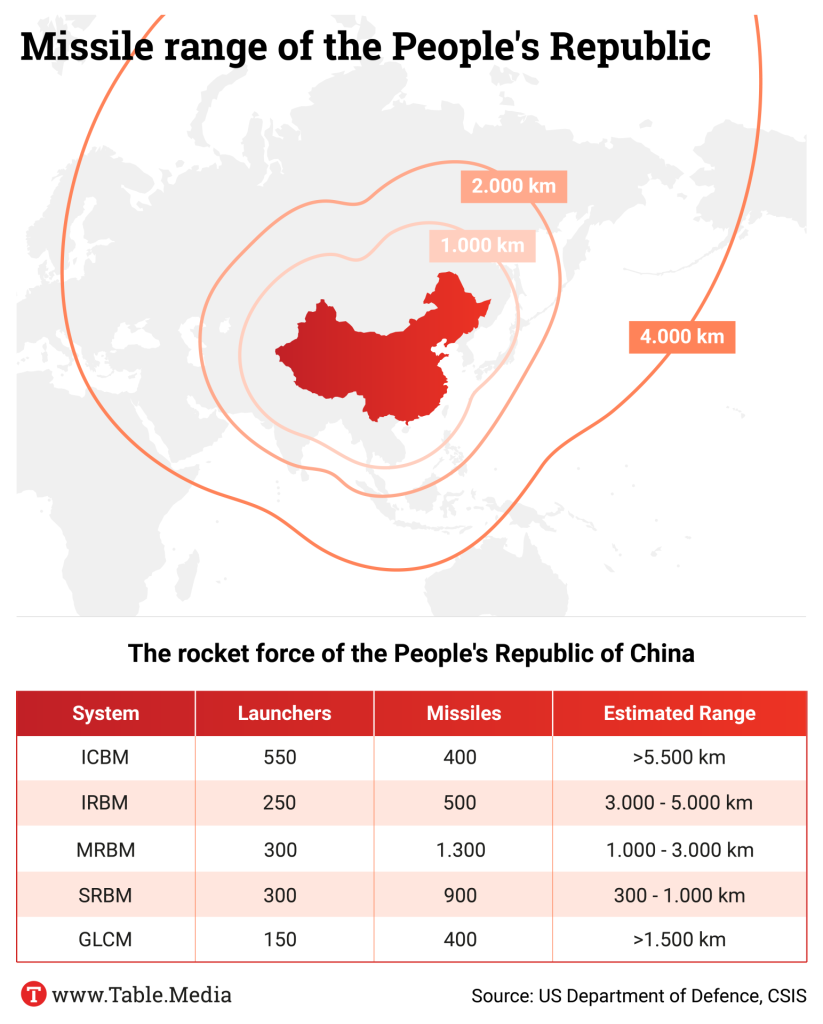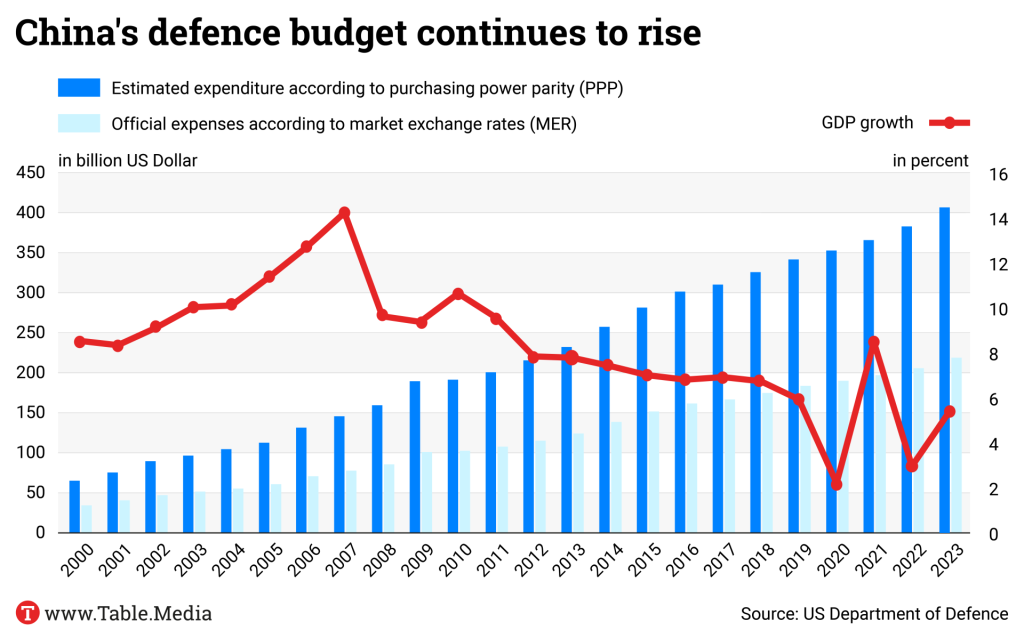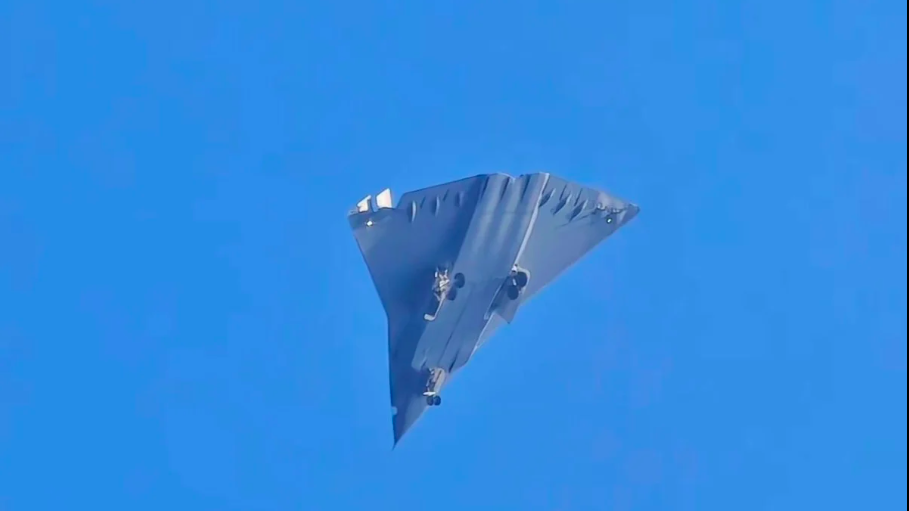Corruption scandals and China’s economic weakness are weighing on the People’s Liberation Army – but it is nevertheless continuing its massive arms build-up. According to the latest Pentagon report, China has developed into a highly modern armed force and its actual military expenditure could be significantly higher than officially stated. China is also rapidly expanding its nuclear arsenal and could have more than 1,000 warheads by 2030.
This is a clear signal to the USA, writes Andreas Landwehr in his Analysis and explains what the results of the report mean for Taiwan and therefore also for global security.
Jörn Petring also looks at the military in his article today. On Dec. 26, China sent two new fighter jets into the air, which experts classify as representatives of the sixth generation. They could revolutionize military power in the air and change the balance of power with the USA. But how far along is China really and what does Elon Musk have to do with it?
I wish you an exciting read!


Although there is corruption in the Chinese military, the People’s Liberation Army has developed into a force that should not be underestimated. The Pentagon’s annual report on China’s military capabilities paints a picture of a massive and successful rearmament program. Despite the weaker growth of the second largest economy, foreign experts see Beijing’s unsurpassed ability to mobilize resources.
China’s head of state and party leader Xi Jinping “commands a system riven by brutal elite power struggles, but he is determined to gain control of Taiwan with an increasingly powerful toolkit,” comments Andrew Erickson of the US Naval War College. “With deadly seriousness, he continues to push ahead with comprehensive organizational reforms to maximize the necessary warfighting capabilities.” Of particular concern is the rapid expansion of nuclear forces, which is intended to deter the US from any intervention – especially in a conflict over Taiwan.

While China previously only had a small nuclear arsenal, the Pentagon estimates that its number of operational nuclear weapons has risen to more than 600. By 2030, it is likely to have more than 1,000 warheads – approaching the figure of 1,600 each for the USA and Russia. The Pentagon believes that China will continue to expand its arsenal after that. China’s military modernization “suggests that it seeks the capability to inflict far greater, overwhelming damage on an adversary in the context of nuclear war”.
For the first time, the report contains a chapter on corruption, which made headlines because at least 15 leading military officers and five defense industry managers were brought down. Not only were the last two defense ministers dismissed, but most recently also General Miao Hua, a member of the powerful military commission under Xi. The accusations are based on “violations of party discipline,” often used to describe corruption.
The Pentagon report speculates that the investigation “may have disrupted” modernization. “I think it’s already having some impact,” comments a senior defense official, who sees a possible braking factor. China expert Erickson from the Naval War College, on the other hand, sees at most “some dirty laundry”: “But basically it’s more of a speed bump, not a showstopper” – in other words, not a decisive factor.
“It would be a mistake to focus on this problem while ignoring the significant progress China is clearly making in building a highly modern and capable military that can threaten the US, its allies and partners,” says David Sacks of the US think tank Council of Foreign Relations. The fact that Xi Jinping wants to continue to aggressively root out corruption demonstrates his determination “to have a military that offers him credible options for realizing his political goals, first and foremost unification with Taiwan”.
Even the weaker economy in China is by no means slowing down the armament. The Pentagon report clearly shows that it is “full steam ahead”, as Zack Cooper from the American Enterprise Institute (AEI) is quoted in “Air and Space Forces Magazine”.
The Pentagon report estimates China’s true military spending to be 40 to 90 percent higher than the official budget. Last year, with an increase of 7.2 percent, it amounted to around 1.9 trillion yuan, the equivalent of €205 billion (around USD 259 billion). According to US estimates, China’s actual military budget could be almost half the size of US defense spending, which amounted to around USD 884 billion in 2024.
“There is a consensus among experts that the publicly announced defense spending of the People’s Republic of China does not include the People’s Republic’s entire investment in its defense,” the Pentagon report states.

A lot of money flows into the naval forces. In terms of numbers, China has the largest naval forces in the world – with more than 370 ships and submarines, according to the Pentagon. The aim is to have 435 ships by 2030. The aim is to project military power into other regions of the world. The ability to carry out missions beyond the “First Island Chain”, which refers to the waters in the western Pacific from Japan to Taiwan, the Philippines, and deep into the South China Sea, has increased.
China wants to build supply bases in other countries in addition to its base in Djibouti on the Horn of Africa and a pier in Cambodia’s naval port of Ream. The need is “tremendous”, says US Deputy Secretary of Defense Ely Ratner at a discussion held by the US think tank Center for Strategic and International Studies (CSIS). “They’ll take almost anything they can get anywhere in the world.”
Modernization is driven by a world-class defense industry. “The People’s Republic is the world’s largest shipbuilder by tonnage and can produce a wide range of combat ships, gas turbine and diesel-powered engines, and shipboard weapons and electronic systems, making the country virtually self-sufficient in shipbuilding,” the Pentagon report states.
Taiwan and the USA, which are committed to the island republic’s defense capability, are at the heart of the armament. China has increased the pressure on Taiwan through large-scale maneuvers. The previously respected, unofficial center line in the Taiwan Strait is now frequently crossed or Taiwan’s air surveillance zone (ADIZ) violated. According to the report, China is also aiming to “deter, prevent or, if ordered, thwart” US intervention.
Despite all the progress, however, the Pentagon believes, at least for now, that an invasion of Taiwan is “neither imminent nor inevitable”, as Ratner says. “We believe that deterrence is real, that deterrence is strong.” It will take a lot of work to keep it that way, says the senior official, without directly addressing the new presidency of Donald Trump, who has already called for more military spending by Taiwan.
The aim of the People’s Liberation Army is to feel ready and confident to carry out a brief invasion of Taiwan “at an acceptable cost”, Ratner says. “Today, they’re not there yet. They’re trying to get there.” The report shows that. “But it’s not clear that they’re any closer to that goal than they have been in recent years.”
What is more feared in Taiwan’s presidential palace is a scenario described as a “quarantine” with inspections and blockades for merchant ships to force Taipei to negotiate an “agreement”. “It will probably come true one day,” according to an adviser to new President Lai Ching-te. China’s navy and coast guard are already preparing for this.
The Pentagon is also concerned about Chinese plans to block sea or air traffic to Taiwan or to interrupt the import of important goods. The aim of such campaigns is to “force Taiwan to capitulate before reunification”.

On Dec. 26, China showed the world two new types of fighter aircraft for the first time, which experts classify as potential representatives of the sixth generation. Both models have a futuristic, tailless design, which should improve their stealth characteristics. One of the aircraft apparently has three engines, while the smaller model has two.
The test flights of the as-yet-unnamed jets took place in Chengdu and Shenyang. The cities are home to China’s two largest fighter jet manufacturers. Footage of the flights was shared millions of times on social media. The date of the tests was apparently deliberately chosen to coincide with Mao Zedong’s birthday.
The Chinese military has not yet officially confirmed the aircraft but has given indirect hints. A New Year video from the Eastern Theater Command of the People’s Liberation Army showed a ginkgo leaf that strongly resembles the shape of the new jets. The state media reported on this in detail.
Observers see different possible uses for the two aircraft. According to Chinese military expert Du Wenlong, they are based on different design concepts. The smaller, more maneuverable jet could become part of the carrier aircraft fleet in the future, Wu told the South China Morning Post. The larger jet, on the other hand, could serve as a command center to control autonomous combat drones, for example.
Australian military analyst Malcolm Davis believes that China will do everything in its power to finish developing the two aircraft quickly. “Beijing will not miss an opportunity to humiliate the US by deploying a sixth-generation platform ahead of the US,” Davis told Breakingdefence.com. If Beijing succeeds in this, it will gain strategic advantages.
However, there is a lack of concrete information. According to Davis, the smaller jet in particular is difficult to recognize in the videos, which makes it difficult to assess its capabilities. In the past, China has often presented immature weapons systems to demonstrate military strength.
However, it is also clear that the development of a sixth-generation jet is currently slow in the USA. The Next Generation Air Dominance (NGAD) program comprises a manned combat aircraft that is to be accompanied by unmanned drones.
However, there are significant challenges, with high costs and a changing threat environment recently leading to extensive reviews. According to Deutsche Bank analyst Scott Deuschle, China’s developments could now accelerate the need for NGAD again. Deuschle recently downgraded Lockheed Martin’s stock because he expects that the US, driven by the new Chinese jets, could rely less on the F-35 built by the company in the future and instead switch to sixth-generation aircraft more quickly.
However, a radical change in strategy is also possible under Donald Trump in the White House. Elon Musk, his most important advisor, recently described manned fighter jets as obsolete and advocated completely unmanned drone systems. If Musk gets his way, the NGAD program could possibly be discontinued completely.
China’s military has achieved a PR success with the tests, at least in its own country. And it is urgently needed. After all, the People’s Liberation Army has recently made negative headlines, particularly with corruption scandals. The annual air show in Zhuhai, where China’s air force usually puts on a show, was also overshadowed by a tragedy in November: A rampage in the city claimed 35 lives. The test flights and their dissemination on social media are now providing much-needed positive attention.
China has denied responsibility for the cut undersea cable off Taiwan. The director of the company Jie Yang Trading Limited, Guo Wenjie, confirmed that the ship had passed the northern coast of Taiwan. However, according to information from Reuters, the freighter had nothing to do with the damage to the cable. The freighter had complied with all regulations. Guo Wenjie did not explain why the ship had been off Taiwan for almost a month. Jie Yang is registered in Hong Kong, Guo Wenjie is mainland Chinese.
The Chinese Taiwan Affairs Office also went on the offensive. In a statement, the office wrote that such incidents were nothing out of the ordinary, with more than 100 occurring every year. It accused Taiwan of plucking the accusation out of the air. The intention was to deliberately draw attention to the gray area around the island. The Taiwanese government regularly complains about damaging incursions by China near its coast, but these do not yet constitute an act of war. The office did not comment on whether the ship was involved in the incident.
The freighter “Shunxing39” was off the coast of Taiwan from the beginning of December until Jan. 3. Satellite data is said to show that the anchor dragged on the seabed. Taiwan therefore suspected that the undersea cable had been deliberately destroyed. The data link connects Taiwan with the US coast and was only interrupted briefly. Nevertheless, Taiwan fears that China could also cut the undersea cable in the event of an attack on the island.
Drone expert and start-up founder Zhang Daibing is dead. He died at the age of 47, the cause of death is still unclear. His death was confirmed in a statement from his family, as reported by the South China Morning Post. Zhang was one of China’s top drone experts and was deputy director of the Research Institute of Unmanned Systems at his alma mater, the National University of Defense Technology (NUDT) in Changsha.
Zhang was also part of the People’s Liberation Army’s expert group for drone systems and also worked as an entrepreneur: His company Yunzhihang Technology Co, Ltd developed drones for firefighting in high-rise buildings, among other things.
Zhang’s interest in drones went beyond purely military purposes: He is said to have called for drones to be used in industry as well. Despite his successes, Zhang did not seem to have any entrepreneurial luck: A CCTV commentator described him as a “failed entrepreneur”. ek
China wants to boost sluggish domestic demand and get the economy back on track by expanding a program to promote the exchange of old consumer goods for new ones. This year, microwaves, water filters, dishwashers and rice cookers are to be included in the exchange program, according to a document published by the state planning and finance ministry on Wednesday. Smartphones, tablets, smartwatches and fitness wristbands that cost less than 6000 yuan (around €790) are to be subsidized by 15 percent.
As a representative of the Ministry of Finance announced at a press conference, the central government has so far provided 81 billion yuan (around €10.4 billion) for the program. According to the Ministry of Commerce, last year the campaign led to car sales worth 920 billion yuan and sales of household appliances worth 240 billion yuan. The Chinese leadership has promised to “vigorously” boost consumption and expand domestic demand “in all directions” this year. Last week, the government announced wage increases for millions of state employees across China, also in a bid to boost consumption. rtr
China plans to connect at least 200 gigawatts of new solar and wind power capacity to its grid between 2025 and 2027. This is according to a new “Action Plan for Optimizing Grid Control Capacity” from the National Development and Reform Commission (NDRC). The plan states that curtailment, meaning the shutdown of renewable energies during peak production phases to protect the power grid, will be reduced to less than ten percent of capacity, a slight increase from the previous target of five percent.
Despite the rapid expansion of renewables, there are differing views on further growth within China. Solar and wind energy associations forecast a fairly constant expansion rate of 245 to 280 gigawatts (solar) and 50 to 60 gigawatts (wind power) of new capacity per year. The chairman of the National Energy Administration (NEA), Zhang Jianhua, on the other hand, suggested last summer that only “over 100 gigawatts” of new renewable energy capacity should be added – much less than has been installed in recent years.
According to analyst Lauri Myllyvirta from the Centre for Research on Energy and Clean Air, there may have been an undisclosed curtailment of solar and wind farms in China in November. In the winter month, coal-fired power generation increased by one percent and gas-fired power generation by four percent, despite falling power demand. Solar and wind energy “should have easily covered demand growth and pushed coal and gas-fired generation down,” Myllyvirta writes on Bluesky. He sees the most likely explanation in “a major increase in curtailment” of solar and wind farms.
However, the official data does not contain any information on this. According to the China expert, this points to two problems: Problems with integrating renewables into the power grid and susceptibility to manipulation of the curtailment data. However, he believes that the problem is not due to an overload of the grid, but to the fact that coal-fired power is not flexible enough and that vested interests block cross-provincial electricity trading. nib

The birthday cake comes from Germany. In China, it has not only experienced an amazing success story, but has also undergone an impressive transformation in contact with Chinese culture. In fact, it has become a cultural product in its own right in China: Compare, for example, the sight of ornately decorated Chinese cakes with that of a German crumble cake.
Artist and filmmaker Zhang Shengjia’s documentary “Birthday Cakes from China” tells the story of birthday cakes in China and the influence of US fast food chains on the People’s Republic – and thus also on the recent history of his country.
Two years ago, he was in Bangkok for his birthday. He and his friends were looking in vain for a cake, as they know it from China for this occasion, says the 27-year-old in an interview with Table.Briefings. “At some point, I asked myself: Why do I need a cake at all?” He realized that a cake with candles was actually a Western tradition – and that made him curious.

The way of life in his home country and the question of how different cultures influence each other play a key role in Zhang Shengjia’s art. In a series of installations, he focuses on the street shrines of his hometown of Shenzhen. The video installation “Made in England” revolves around the Willow pattern, the famous blue and white chinoiserie pattern on English crockery.
Zhang studied interior design at Shenzhen University and art at Central Saint Martins College of Art and Design in London. He still lives partly in London, where he pursues mudlarking. He finds objects in the mud on the banks of the Thames that inspire his art. This is how “Made in England” came about.
For “Birthday Cakes from China”, he worked his way through vast amounts of archive material, on the Internet, at flea markets, and in his own family’s photo collection. The film begins with footage of the artist’s ninth birthday in a KFC branch. The fast food chains and their advertising have played a decisive role in shaping the image of children’s birthdays in China, according to the film. “If you celebrated your birthday at KFC or McDonalds, you could show that you were a cool guy. The family could show that they belonged to the middle class.”
But the branches were often more than just a commercial event: Zhang says that the first KFC branch on Qianmen Street in Beijing was a popular meeting place for artists in the 1990s.
The artist’s research goes back to Yuan Shikai – he is said to have been the first Chinese person to celebrate his birthday with a cake, at Café Kiessling in Tianjin. He was unable to find much material from the time of the Cultural Revolution. But after the economic reforms in the 1980s, cakes were everywhere, and a unique style developed – also thanks to the influence of former Chinese emigrants who came back to the People’s Republic from Malaysia, for example, after the reforms. Zhang says: “I see the birthday cake as a symbol of liberalization and economic development.”
In the meantime, however, something has changed, the social mood has become more aggressive, more nationalistic. “Something is different, I can’t say exactly what it is,” says Zhang. Sarah Schaefer
“Birthday Cakes from China” was shown at the Beijing International Short Film Festival and the Leipzig Festival for Documentary Film, among others.
Zhe Zhao has been Lead of Export Control Compliance, Greater China at Bosch since November. Previously, Zhao worked in Trade Compliance and Export Control at Volvo. He will continue to be based in Shanghai.
Teng Hui has been VP of Global sourcing Nacelle & Global sourcing China at the Nordex Group since January. Before joining the Hamburg-based supplier of wind turbines, Teng was Global Head of Procurement for Siemens Gamesa. He is based in Shanghai.
Is something changing in your organization? Send a note for our personnel section to heads@table.media!

Harbin in Heilongjiang province is known for its impressive ice sculptures, which attract thousands of tourists to the city every January during the International Ice and Snow Festival. An ice replica of China’s aircraft carrier Liaoning can currently be seen in the Daowai District there. The ship, made of pre-cut blocks, is 65 meters long, 15 meters wide and 13 meters high. On the high seas, it could certainly ram an iceberg or two without damage.
Corruption scandals and China’s economic weakness are weighing on the People’s Liberation Army – but it is nevertheless continuing its massive arms build-up. According to the latest Pentagon report, China has developed into a highly modern armed force and its actual military expenditure could be significantly higher than officially stated. China is also rapidly expanding its nuclear arsenal and could have more than 1,000 warheads by 2030.
This is a clear signal to the USA, writes Andreas Landwehr in his Analysis and explains what the results of the report mean for Taiwan and therefore also for global security.
Jörn Petring also looks at the military in his article today. On Dec. 26, China sent two new fighter jets into the air, which experts classify as representatives of the sixth generation. They could revolutionize military power in the air and change the balance of power with the USA. But how far along is China really and what does Elon Musk have to do with it?
I wish you an exciting read!


Although there is corruption in the Chinese military, the People’s Liberation Army has developed into a force that should not be underestimated. The Pentagon’s annual report on China’s military capabilities paints a picture of a massive and successful rearmament program. Despite the weaker growth of the second largest economy, foreign experts see Beijing’s unsurpassed ability to mobilize resources.
China’s head of state and party leader Xi Jinping “commands a system riven by brutal elite power struggles, but he is determined to gain control of Taiwan with an increasingly powerful toolkit,” comments Andrew Erickson of the US Naval War College. “With deadly seriousness, he continues to push ahead with comprehensive organizational reforms to maximize the necessary warfighting capabilities.” Of particular concern is the rapid expansion of nuclear forces, which is intended to deter the US from any intervention – especially in a conflict over Taiwan.

While China previously only had a small nuclear arsenal, the Pentagon estimates that its number of operational nuclear weapons has risen to more than 600. By 2030, it is likely to have more than 1,000 warheads – approaching the figure of 1,600 each for the USA and Russia. The Pentagon believes that China will continue to expand its arsenal after that. China’s military modernization “suggests that it seeks the capability to inflict far greater, overwhelming damage on an adversary in the context of nuclear war”.
For the first time, the report contains a chapter on corruption, which made headlines because at least 15 leading military officers and five defense industry managers were brought down. Not only were the last two defense ministers dismissed, but most recently also General Miao Hua, a member of the powerful military commission under Xi. The accusations are based on “violations of party discipline,” often used to describe corruption.
The Pentagon report speculates that the investigation “may have disrupted” modernization. “I think it’s already having some impact,” comments a senior defense official, who sees a possible braking factor. China expert Erickson from the Naval War College, on the other hand, sees at most “some dirty laundry”: “But basically it’s more of a speed bump, not a showstopper” – in other words, not a decisive factor.
“It would be a mistake to focus on this problem while ignoring the significant progress China is clearly making in building a highly modern and capable military that can threaten the US, its allies and partners,” says David Sacks of the US think tank Council of Foreign Relations. The fact that Xi Jinping wants to continue to aggressively root out corruption demonstrates his determination “to have a military that offers him credible options for realizing his political goals, first and foremost unification with Taiwan”.
Even the weaker economy in China is by no means slowing down the armament. The Pentagon report clearly shows that it is “full steam ahead”, as Zack Cooper from the American Enterprise Institute (AEI) is quoted in “Air and Space Forces Magazine”.
The Pentagon report estimates China’s true military spending to be 40 to 90 percent higher than the official budget. Last year, with an increase of 7.2 percent, it amounted to around 1.9 trillion yuan, the equivalent of €205 billion (around USD 259 billion). According to US estimates, China’s actual military budget could be almost half the size of US defense spending, which amounted to around USD 884 billion in 2024.
“There is a consensus among experts that the publicly announced defense spending of the People’s Republic of China does not include the People’s Republic’s entire investment in its defense,” the Pentagon report states.

A lot of money flows into the naval forces. In terms of numbers, China has the largest naval forces in the world – with more than 370 ships and submarines, according to the Pentagon. The aim is to have 435 ships by 2030. The aim is to project military power into other regions of the world. The ability to carry out missions beyond the “First Island Chain”, which refers to the waters in the western Pacific from Japan to Taiwan, the Philippines, and deep into the South China Sea, has increased.
China wants to build supply bases in other countries in addition to its base in Djibouti on the Horn of Africa and a pier in Cambodia’s naval port of Ream. The need is “tremendous”, says US Deputy Secretary of Defense Ely Ratner at a discussion held by the US think tank Center for Strategic and International Studies (CSIS). “They’ll take almost anything they can get anywhere in the world.”
Modernization is driven by a world-class defense industry. “The People’s Republic is the world’s largest shipbuilder by tonnage and can produce a wide range of combat ships, gas turbine and diesel-powered engines, and shipboard weapons and electronic systems, making the country virtually self-sufficient in shipbuilding,” the Pentagon report states.
Taiwan and the USA, which are committed to the island republic’s defense capability, are at the heart of the armament. China has increased the pressure on Taiwan through large-scale maneuvers. The previously respected, unofficial center line in the Taiwan Strait is now frequently crossed or Taiwan’s air surveillance zone (ADIZ) violated. According to the report, China is also aiming to “deter, prevent or, if ordered, thwart” US intervention.
Despite all the progress, however, the Pentagon believes, at least for now, that an invasion of Taiwan is “neither imminent nor inevitable”, as Ratner says. “We believe that deterrence is real, that deterrence is strong.” It will take a lot of work to keep it that way, says the senior official, without directly addressing the new presidency of Donald Trump, who has already called for more military spending by Taiwan.
The aim of the People’s Liberation Army is to feel ready and confident to carry out a brief invasion of Taiwan “at an acceptable cost”, Ratner says. “Today, they’re not there yet. They’re trying to get there.” The report shows that. “But it’s not clear that they’re any closer to that goal than they have been in recent years.”
What is more feared in Taiwan’s presidential palace is a scenario described as a “quarantine” with inspections and blockades for merchant ships to force Taipei to negotiate an “agreement”. “It will probably come true one day,” according to an adviser to new President Lai Ching-te. China’s navy and coast guard are already preparing for this.
The Pentagon is also concerned about Chinese plans to block sea or air traffic to Taiwan or to interrupt the import of important goods. The aim of such campaigns is to “force Taiwan to capitulate before reunification”.

On Dec. 26, China showed the world two new types of fighter aircraft for the first time, which experts classify as potential representatives of the sixth generation. Both models have a futuristic, tailless design, which should improve their stealth characteristics. One of the aircraft apparently has three engines, while the smaller model has two.
The test flights of the as-yet-unnamed jets took place in Chengdu and Shenyang. The cities are home to China’s two largest fighter jet manufacturers. Footage of the flights was shared millions of times on social media. The date of the tests was apparently deliberately chosen to coincide with Mao Zedong’s birthday.
The Chinese military has not yet officially confirmed the aircraft but has given indirect hints. A New Year video from the Eastern Theater Command of the People’s Liberation Army showed a ginkgo leaf that strongly resembles the shape of the new jets. The state media reported on this in detail.
Observers see different possible uses for the two aircraft. According to Chinese military expert Du Wenlong, they are based on different design concepts. The smaller, more maneuverable jet could become part of the carrier aircraft fleet in the future, Wu told the South China Morning Post. The larger jet, on the other hand, could serve as a command center to control autonomous combat drones, for example.
Australian military analyst Malcolm Davis believes that China will do everything in its power to finish developing the two aircraft quickly. “Beijing will not miss an opportunity to humiliate the US by deploying a sixth-generation platform ahead of the US,” Davis told Breakingdefence.com. If Beijing succeeds in this, it will gain strategic advantages.
However, there is a lack of concrete information. According to Davis, the smaller jet in particular is difficult to recognize in the videos, which makes it difficult to assess its capabilities. In the past, China has often presented immature weapons systems to demonstrate military strength.
However, it is also clear that the development of a sixth-generation jet is currently slow in the USA. The Next Generation Air Dominance (NGAD) program comprises a manned combat aircraft that is to be accompanied by unmanned drones.
However, there are significant challenges, with high costs and a changing threat environment recently leading to extensive reviews. According to Deutsche Bank analyst Scott Deuschle, China’s developments could now accelerate the need for NGAD again. Deuschle recently downgraded Lockheed Martin’s stock because he expects that the US, driven by the new Chinese jets, could rely less on the F-35 built by the company in the future and instead switch to sixth-generation aircraft more quickly.
However, a radical change in strategy is also possible under Donald Trump in the White House. Elon Musk, his most important advisor, recently described manned fighter jets as obsolete and advocated completely unmanned drone systems. If Musk gets his way, the NGAD program could possibly be discontinued completely.
China’s military has achieved a PR success with the tests, at least in its own country. And it is urgently needed. After all, the People’s Liberation Army has recently made negative headlines, particularly with corruption scandals. The annual air show in Zhuhai, where China’s air force usually puts on a show, was also overshadowed by a tragedy in November: A rampage in the city claimed 35 lives. The test flights and their dissemination on social media are now providing much-needed positive attention.
China has denied responsibility for the cut undersea cable off Taiwan. The director of the company Jie Yang Trading Limited, Guo Wenjie, confirmed that the ship had passed the northern coast of Taiwan. However, according to information from Reuters, the freighter had nothing to do with the damage to the cable. The freighter had complied with all regulations. Guo Wenjie did not explain why the ship had been off Taiwan for almost a month. Jie Yang is registered in Hong Kong, Guo Wenjie is mainland Chinese.
The Chinese Taiwan Affairs Office also went on the offensive. In a statement, the office wrote that such incidents were nothing out of the ordinary, with more than 100 occurring every year. It accused Taiwan of plucking the accusation out of the air. The intention was to deliberately draw attention to the gray area around the island. The Taiwanese government regularly complains about damaging incursions by China near its coast, but these do not yet constitute an act of war. The office did not comment on whether the ship was involved in the incident.
The freighter “Shunxing39” was off the coast of Taiwan from the beginning of December until Jan. 3. Satellite data is said to show that the anchor dragged on the seabed. Taiwan therefore suspected that the undersea cable had been deliberately destroyed. The data link connects Taiwan with the US coast and was only interrupted briefly. Nevertheless, Taiwan fears that China could also cut the undersea cable in the event of an attack on the island.
Drone expert and start-up founder Zhang Daibing is dead. He died at the age of 47, the cause of death is still unclear. His death was confirmed in a statement from his family, as reported by the South China Morning Post. Zhang was one of China’s top drone experts and was deputy director of the Research Institute of Unmanned Systems at his alma mater, the National University of Defense Technology (NUDT) in Changsha.
Zhang was also part of the People’s Liberation Army’s expert group for drone systems and also worked as an entrepreneur: His company Yunzhihang Technology Co, Ltd developed drones for firefighting in high-rise buildings, among other things.
Zhang’s interest in drones went beyond purely military purposes: He is said to have called for drones to be used in industry as well. Despite his successes, Zhang did not seem to have any entrepreneurial luck: A CCTV commentator described him as a “failed entrepreneur”. ek
China wants to boost sluggish domestic demand and get the economy back on track by expanding a program to promote the exchange of old consumer goods for new ones. This year, microwaves, water filters, dishwashers and rice cookers are to be included in the exchange program, according to a document published by the state planning and finance ministry on Wednesday. Smartphones, tablets, smartwatches and fitness wristbands that cost less than 6000 yuan (around €790) are to be subsidized by 15 percent.
As a representative of the Ministry of Finance announced at a press conference, the central government has so far provided 81 billion yuan (around €10.4 billion) for the program. According to the Ministry of Commerce, last year the campaign led to car sales worth 920 billion yuan and sales of household appliances worth 240 billion yuan. The Chinese leadership has promised to “vigorously” boost consumption and expand domestic demand “in all directions” this year. Last week, the government announced wage increases for millions of state employees across China, also in a bid to boost consumption. rtr
China plans to connect at least 200 gigawatts of new solar and wind power capacity to its grid between 2025 and 2027. This is according to a new “Action Plan for Optimizing Grid Control Capacity” from the National Development and Reform Commission (NDRC). The plan states that curtailment, meaning the shutdown of renewable energies during peak production phases to protect the power grid, will be reduced to less than ten percent of capacity, a slight increase from the previous target of five percent.
Despite the rapid expansion of renewables, there are differing views on further growth within China. Solar and wind energy associations forecast a fairly constant expansion rate of 245 to 280 gigawatts (solar) and 50 to 60 gigawatts (wind power) of new capacity per year. The chairman of the National Energy Administration (NEA), Zhang Jianhua, on the other hand, suggested last summer that only “over 100 gigawatts” of new renewable energy capacity should be added – much less than has been installed in recent years.
According to analyst Lauri Myllyvirta from the Centre for Research on Energy and Clean Air, there may have been an undisclosed curtailment of solar and wind farms in China in November. In the winter month, coal-fired power generation increased by one percent and gas-fired power generation by four percent, despite falling power demand. Solar and wind energy “should have easily covered demand growth and pushed coal and gas-fired generation down,” Myllyvirta writes on Bluesky. He sees the most likely explanation in “a major increase in curtailment” of solar and wind farms.
However, the official data does not contain any information on this. According to the China expert, this points to two problems: Problems with integrating renewables into the power grid and susceptibility to manipulation of the curtailment data. However, he believes that the problem is not due to an overload of the grid, but to the fact that coal-fired power is not flexible enough and that vested interests block cross-provincial electricity trading. nib

The birthday cake comes from Germany. In China, it has not only experienced an amazing success story, but has also undergone an impressive transformation in contact with Chinese culture. In fact, it has become a cultural product in its own right in China: Compare, for example, the sight of ornately decorated Chinese cakes with that of a German crumble cake.
Artist and filmmaker Zhang Shengjia’s documentary “Birthday Cakes from China” tells the story of birthday cakes in China and the influence of US fast food chains on the People’s Republic – and thus also on the recent history of his country.
Two years ago, he was in Bangkok for his birthday. He and his friends were looking in vain for a cake, as they know it from China for this occasion, says the 27-year-old in an interview with Table.Briefings. “At some point, I asked myself: Why do I need a cake at all?” He realized that a cake with candles was actually a Western tradition – and that made him curious.

The way of life in his home country and the question of how different cultures influence each other play a key role in Zhang Shengjia’s art. In a series of installations, he focuses on the street shrines of his hometown of Shenzhen. The video installation “Made in England” revolves around the Willow pattern, the famous blue and white chinoiserie pattern on English crockery.
Zhang studied interior design at Shenzhen University and art at Central Saint Martins College of Art and Design in London. He still lives partly in London, where he pursues mudlarking. He finds objects in the mud on the banks of the Thames that inspire his art. This is how “Made in England” came about.
For “Birthday Cakes from China”, he worked his way through vast amounts of archive material, on the Internet, at flea markets, and in his own family’s photo collection. The film begins with footage of the artist’s ninth birthday in a KFC branch. The fast food chains and their advertising have played a decisive role in shaping the image of children’s birthdays in China, according to the film. “If you celebrated your birthday at KFC or McDonalds, you could show that you were a cool guy. The family could show that they belonged to the middle class.”
But the branches were often more than just a commercial event: Zhang says that the first KFC branch on Qianmen Street in Beijing was a popular meeting place for artists in the 1990s.
The artist’s research goes back to Yuan Shikai – he is said to have been the first Chinese person to celebrate his birthday with a cake, at Café Kiessling in Tianjin. He was unable to find much material from the time of the Cultural Revolution. But after the economic reforms in the 1980s, cakes were everywhere, and a unique style developed – also thanks to the influence of former Chinese emigrants who came back to the People’s Republic from Malaysia, for example, after the reforms. Zhang says: “I see the birthday cake as a symbol of liberalization and economic development.”
In the meantime, however, something has changed, the social mood has become more aggressive, more nationalistic. “Something is different, I can’t say exactly what it is,” says Zhang. Sarah Schaefer
“Birthday Cakes from China” was shown at the Beijing International Short Film Festival and the Leipzig Festival for Documentary Film, among others.
Zhe Zhao has been Lead of Export Control Compliance, Greater China at Bosch since November. Previously, Zhao worked in Trade Compliance and Export Control at Volvo. He will continue to be based in Shanghai.
Teng Hui has been VP of Global sourcing Nacelle & Global sourcing China at the Nordex Group since January. Before joining the Hamburg-based supplier of wind turbines, Teng was Global Head of Procurement for Siemens Gamesa. He is based in Shanghai.
Is something changing in your organization? Send a note for our personnel section to heads@table.media!

Harbin in Heilongjiang province is known for its impressive ice sculptures, which attract thousands of tourists to the city every January during the International Ice and Snow Festival. An ice replica of China’s aircraft carrier Liaoning can currently be seen in the Daowai District there. The ship, made of pre-cut blocks, is 65 meters long, 15 meters wide and 13 meters high. On the high seas, it could certainly ram an iceberg or two without damage.
